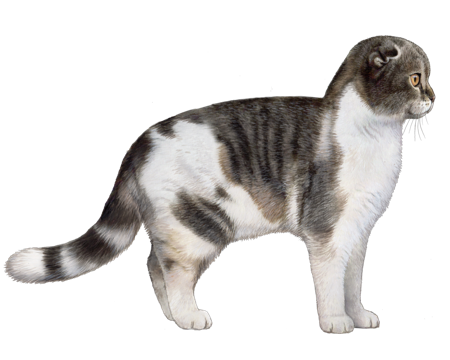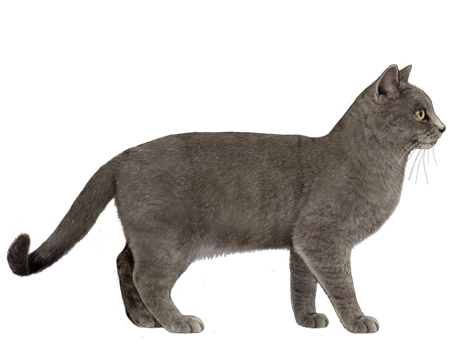
Scottish Fold
Scottish Folds are gentle, calm cats with an owl-like appearance. Their sweet, social nature and undemanding attitude make them an excellent fit for most families.
Interested in discovering if your cat is a Scottish Fold?
Check out Wisdom Panel's DNA test.
Scottish Fold Traits
General Appearance
Scottish Folds are medium-sized cats with adorable round faces. All Folds are born with straight ears that fold in after about 3-4 weeks if the kittens carry the gene mutation. This mutation occurs in about 50% of kittens born in Scottish Fold litters. The remaining half (straight-eared kittens) are called "straight-eared Folds" or Scottish Straights.
Coat and Colouring
Scottish Folds come in both shorthair and longhair varieties. Shorthair cats have dense, plush hair that stands away from the body. Longhair cats have full coats with notable britches, tail plumes, toe tufts, and ear furnishings. Their coats come in nearly all colors and patterns.
Distinctive Physical Traits
Folds have rounded heads and wide-open eyes with sweet expressions. Their short noses have a gentle curve and give a moderate profile. Their ears fold forward and down toward their heads—with smaller, tightly folded ears being the preference. Scottish Folds have rounded, well-padded bodies and medium-to-long tails that are flexible and tapering.
Scottish Fold Temperament
Scottish Folds are undemanding cats with sweet dispositions. They have an adaptable nature that makes them well-suited for everything from busy family life to low-key, single-person households.
These loyal cats enjoy curling up next to their favorite human and are champion nappers. But when something gets their attention, they'll sit up like a prairie dog to see what's going on. Though not rowdy or overly-energetic, they do like to play and can learn to fetch.
Folds are generally quiet cats. When they have something to say, they use their tiny voice to get your attention.
Scottish Fold History
Every Scottish Fold can trace its ancestry back to a white barn cat named Susie. Shepherd William Ross saw Susie at a farm in Scotland in 1961. Taken by the way her ears folded down on her head (the result of a rare mutation), Ross asked the farmer if he could have one of Susie's kittens.
Ross then bred the folded-ear kitten with a red tabby and subsequently crossed a kitten from that litter with a white British Shorthair. This resulted in five cats with folded ears—which became the foundation of the Scottish Fold breed.
Interest in the breed grew steadily. But in the mid-1970s, a geneticist found that a third of Scottish Fold kittens developed bone lesions. Concerned this was due to early inbreeding, breeders have worked to increase the gene pool of the Scottish Fold by outcrossing with American and British Shorthairs. (This also meets the breeding guideline of mating a Fold with a cat that has non-folded ears.)
Though careful breeding successfully reduced the occurrence of bone lesions, the problem discouraged breeding programs. Fortunately, breeders in the United States set out to save the Fold. And in 1978, the CFA gave the breed Championship status. The following year, the first Scottish Fold became Grand Champion.
Scottish Fold Care
Nutrition
Scottish Folds require a high-quality diet. Because nutritional needs vary for kittens, adults, and senior cats, be sure to choose a formula that's age-appropriate for your pet.
Roughly one out of every three cats in the United States is overweight or obese. And those extra pounds can contribute to other health risks—such as arthritis, diabetes, and heart problems. Keep calories in check by measuring out meals and reducing portions if your cat gains excess weight. As a guideline, treats should make up no more than 10% of their daily calories.
In addition to meals, make sure to provide your cat with plenty of fresh, clean water.
Grooming
Shorthair Scottish Folds require very little grooming. A weekly once-over with a steel comb is all they need to look their best. Longhair Folds demand more frequent grooming. Brush a few times a week to remove loose hair and prevent mats and tangles.
In addition to brushing, you should trim your cat's nails every few weeks to prevent them from getting too long. Long nails are more likely to snag on something and become torn or damaged. Overgrown nails can also grow into your cat's paw pads, leading to pain or infection.
Finally, dental care—including at-home teeth brushing and regular exams and cleanings—is essential for every cat's long-term health.
Health
Some breeds are more susceptible to certain health conditions. Scottish Folds may be more likely to develop osteochondrodysplasia—an abnormality that affects cartilage and bone development. Your veterinarian is your best resource for discussing these and other health concerns for your cat.
Breed Group
Persian
An ever-popular variety, the breeds within this group tend to share a common genetic connection with Persian cats.
Resources
https://cfa.org/scottish-fold/scottish-fold-article/
https://tica.org/breeds/browse-all-breeds?view=article&id=871:scottish-fold-breed&catid=79
https://vcahospitals.com/know-your-pet/cat-breeds/scottish-fold
https://cfa.org/wp-content/uploads/2019/06/scottish-fold-standard.pdf
https://www.banfield.com/state-of-pet-health/obesity
https://www.pethealthnetwork.com/cat-health/cat-breeds/scottish-fold-0
Reviewed 23 February 2021 by Annette Louviere, DVM






